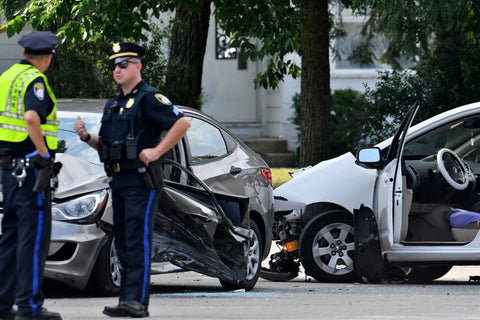
What does CODE 3 mean in Police Terminology? (Explained)
home >> blog articles > what does code 3 mean in police terminology? (explained)

By Brian Humenuk ✍️ COPJOT
Updated on 5/5/2024
🕙 3-minute read or less
Introduction
In law enforcement and, more narrowly speaking, during patrol initiatives, effective communication is essential to ensuring the safety of officers, the public, and those in need of assistance.
Among the hundreds of codes and signals used by police, "Code 3" holds particular significance, indicating a critical and urgent response to an incident. But what exactly does "Code 3" mean in police terms, and how does it impact police operations?
In this article, I am going to deep dive into the concept of Code 3 in police terminology, exploring its definition, response, and role in police communication protocols.
RELATED ARTICLE: >> Police 10 Codes Explained >>
What Does Code 3 Mean in Police Terms?

Code 3 is a widely recognized term in law enforcement circles, indicating an emergency response with lights and sirens activated.
When a police officer or dispatcher calls for a "Code 3" response, it signals an urgent situation requiring immediate assistance or intervention.
This could range from a high-priority call, such as a robbery in progress or a violent altercation, to a life-threatening medical emergency where swift action is needed.
In essence, "Code 3" signifies the highest level of urgency in police dispatch protocols, prompting officers to expedite their response and navigate with caution and priority.
Understanding the Significance of a Code 3 Police Response

The significance of a "Code 3" police response lies in its ability to prioritize critical incidents and allocate resources effectively.
By designating certain situations as "Code 3," law enforcement agencies ensure that officers respond promptly and decisively to emergencies, minimizing response times and maximizing the chances of resolving the situation swiftly and safely.
"Code 3" has a known meaning in the law enforcement world, and it is commonly used terminology across police departments, just like police ranks and the insignia associated with them.
LEARN MORE: >> Common Police Ranks For Most Departments (Ultimate Guide) <<
What is a Code 2 Response in Police Terminology?

A “Code 2" in police terminology typically signifies an urgent but non-life-threatening response to an incident.
Unlike "Code 3," which indicates an emergency response with lights and sirens activated, "Code 2" allows officers to proceed to the scene expeditiously but without the use of emergency lights and sirens.
This designation is commonly used for situations that require prompt attention, such as a disturbance or a minor traffic accident, where a rapid response is warranted but the risk level does not necessarily justify the use of emergency signals.
Code 2 responses enable law enforcement agencies to prioritize calls and allocate resources efficiently, ensuring that officers can address urgent matters while maintaining safety on the roadways.
What is a Code 1 in Police Terminology?
"Code 1" in police terminology indicates a routine or non-urgent response to an incident. Unlike "Code 2" or "Code 3," which signify varying levels of urgency, "Code 1" suggests that the situation does not require immediate attention or the use of lights and sirens during transit.
This designation is often used for non-emergency calls such as routine or directed patrols, administrative tasks, or follow-up investigations where a prompt response is not critical.
By categorizing incidents according to their urgency, law enforcement agencies can prioritize resources effectively and that officers where they are needed most, while minimizing disruptions to public safety.
Code 4: Meaning in Police Response
"Code 4" is a radio communication term used by law enforcement to indicate that a situation is under control and no further assistance is needed.
“Code 4” reassures dispatchers and other responding units that officers on the scene have managed the situation, and the immediate threat has been neutralized or resolved.
Code 4 helps streamline communication, allowing resources to be allocated efficiently and ensuring that officers and emergency personnel are aware that they can stand down or redirect their efforts to other incidents.
About the Author
Brian Humenuk isn't just an entrepreneur in eCommerce; he is also an informed leader whose experience provides followers and visitors with a look into current and past police issues making headlines in the United States.
Brian has earned three degrees in Criminal Justice, with the last, a Master of Science in Criminal Justice Administration.
Brian extends his training, education, and experience to the officers just now getting into the field so that they may become more informed police officers and stay clear of police misconduct and corruption.
You can find out more about Brian and the COPJOT story on the ABOUT US page.
Affiliate Disclosure
COPJOT is supported by its audience. If you purchase through links on this site, I may earn a small affiliate commission. Enough to buy myself a small coffee, and I want to thank you in advance.
More Information
Are you a Police Officer, Sheriff, or State Trooper, Law Enforcement family member, or friend? Check out our Custom Police Notebooks and Metal Police Uniform Pens on our main website.
Publishing significant Police related blog articles is not the only great thing we do. We manufacture, customize, and personalize Custom Police Notebooks and Notepads for Police Officers and law enforcement agencies worldwide.
Related Articles
What is a Police Officer or Peace Officer
Best Tips for Writing Police Reports
How much money do Police Officers make?
Police Unions and Benevolent Associations; Here's what they are
